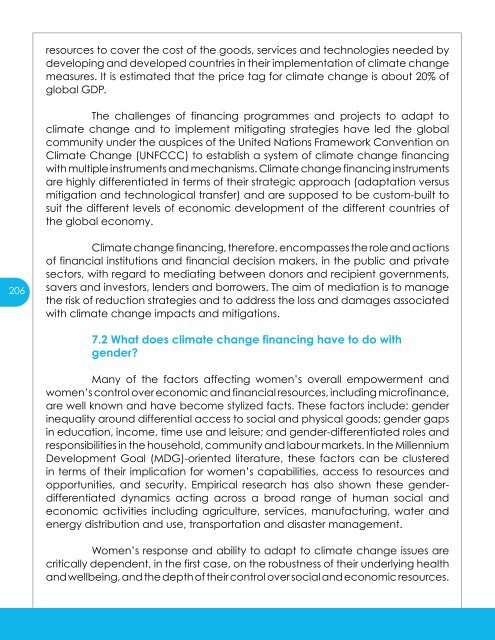GGCA Gender and Climate Change Training Manual - Women's ...
GGCA Gender and Climate Change Training Manual - Women's ...
GGCA Gender and Climate Change Training Manual - Women's ...
You also want an ePaper? Increase the reach of your titles
YUMPU automatically turns print PDFs into web optimized ePapers that Google loves.
esources to cover the cost of the goods, services <strong>and</strong> technologies needed by<br />
developing <strong>and</strong> developed countries in their implementation of climate change<br />
measures. It is estimated that the price tag for climate change is about 20% of<br />
global GDP.<br />
The challenges of financing programmes <strong>and</strong> projects to adapt to<br />
climate change <strong>and</strong> to implement mitigating strategies have led the global<br />
community under the auspices of the United Nations Framework Convention on<br />
<strong>Climate</strong> <strong>Change</strong> (UNFCCC) to establish a system of climate change financing<br />
with multiple instruments <strong>and</strong> mechanisms. <strong>Climate</strong> change financing instruments<br />
are highly differentiated in terms of their strategic approach (adaptation versus<br />
mitigation <strong>and</strong> technological transfer) <strong>and</strong> are supposed to be custom-built to<br />
suit the different levels of economic development of the different countries of<br />
the global economy.<br />
206<br />
<strong>Climate</strong> change financing, therefore, encompasses the role <strong>and</strong> actions<br />
of financial institutions <strong>and</strong> financial decision makers, in the public <strong>and</strong> private<br />
sectors, with regard to mediating between donors <strong>and</strong> recipient governments,<br />
savers <strong>and</strong> investors, lenders <strong>and</strong> borrowers. The aim of mediation is to manage<br />
the risk of reduction strategies <strong>and</strong> to address the loss <strong>and</strong> damages associated<br />
with climate change impacts <strong>and</strong> mitigations.<br />
7.2 What does climate change financing have to do with<br />
gender?<br />
Many of the factors affecting women’s overall empowerment <strong>and</strong><br />
women’s control over economic <strong>and</strong> financial resources, including microfinance,<br />
are well known <strong>and</strong> have become stylized facts. These factors include: gender<br />
inequality around differential access to social <strong>and</strong> physical goods; gender gaps<br />
in education, income, time use <strong>and</strong> leisure; <strong>and</strong> gender-differentiated roles <strong>and</strong><br />
responsibilities in the household, community <strong>and</strong> labour markets. In the Millennium<br />
Development Goal (MDG)-oriented literature, these factors can be clustered<br />
in terms of their implication for women’s capabilities, access to resources <strong>and</strong><br />
opportunities, <strong>and</strong> security. Empirical research has also shown these genderdifferentiated<br />
dynamics acting across a broad range of human social <strong>and</strong><br />
economic activities including agriculture, services, manufacturing, water <strong>and</strong><br />
energy distribution <strong>and</strong> use, transportation <strong>and</strong> disaster management.<br />
Women’s response <strong>and</strong> ability to adapt to climate change issues are<br />
critically dependent, in the first case, on the robustness of their underlying health<br />
<strong>and</strong> wellbeing, <strong>and</strong> the depth of their control over social <strong>and</strong> economic resources.

















